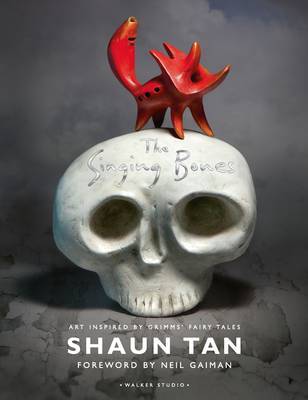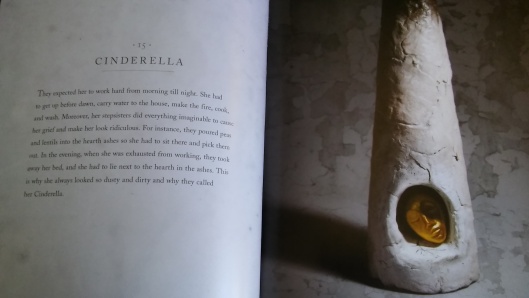Tags

The Singing Bones by Shaun Tan
5/5 stars
The Singing Bones is a gem of a find. Tan has worked to create 75 sculptures as companion pieces to 75 Brother’s Grimm stories and he has done a fabulous job of capturing the darker, truer side of fairy tales and fables. I finished it over the course of a couple hours and it is well worth your time.
I find fairy tales (as well as fables*) fascinating as methods of storytelling and oral culture. I also enjoy fairy tale re-tellings and re-imaginings. Less known about fairy tales, is that they were originally intended to entertain adults, rather than (or in addition to) children. Original versions of stories, including those that the Grimm brothers collected, contained much more darker aspects. The origins of Sleeping Beauty (Sun, Moon, and Talia) contain no evil witch or curse, but do offer rape, intended cannibalism, and burning people alive. The Little Mermaid, even in Hans Christian Anderson’s version, has the mermaid’s feet feeling as if she is walking on sharp knives, hoping to marry the prince in order to gain an immortal soul, and being given the option of murdering the prince to save herself. In the end, it also has a highly religious tone. The same can be said about nearly every fairy tale that still lingers in public memory (especially those that Disney has adapted for children).
The Singing Bones recombines with this dark and forgotten past that fairy tales emerged from which is invoked in the sculptures Tan has created. Their simple style and the setting they are shot in evokes a feeling of being lost in the woods. A spectator dropped into the life of the story. Only a selection of the fairy tale story on the accompanying page offers context, but that is all each piece needs. Even if you are unfamiliar with the stories, it is easy to read into the objects to gather more information. If you’re like me and want to know more about the story, a handy and brief paragraph synopsis is located in the back of the book for your convenience. Tan seemed to have thought of everything in creating this book, which made it a spectacular viewing pleasure. It feels like you are looking at an exhibit. The objects make the stories seem real and tangible–almost in a frightening way.

*Fairy tales are one example of folklore. Folklore is any means by which a group or people express their culture. This encompasses both physical or material culture as well as oral traditions, which is where fairy tales (and fables and parables) come into play. Fairy tales are short stories that typically begin with “once upon a time” and end with an unusually happy or positive ending (for the good guys, at least). Fairy tales have fantasy figures like fairies, dragons, elves, witches, and goblins as well as magical elements. Fables are predominantly known for anthropomorphizing nature, especially in the form of talking animals or plants, in order to teach a moral lesson. Often, there are just 2-3 characters in the story. Parables are direct stories that teach a moral lesson, but without anthropomorphizing nature. Parables are a type of analogy. Allegories, on the other hand, are a type of metaphor that use symbols to convey deeper or hidden meanings in a story.
